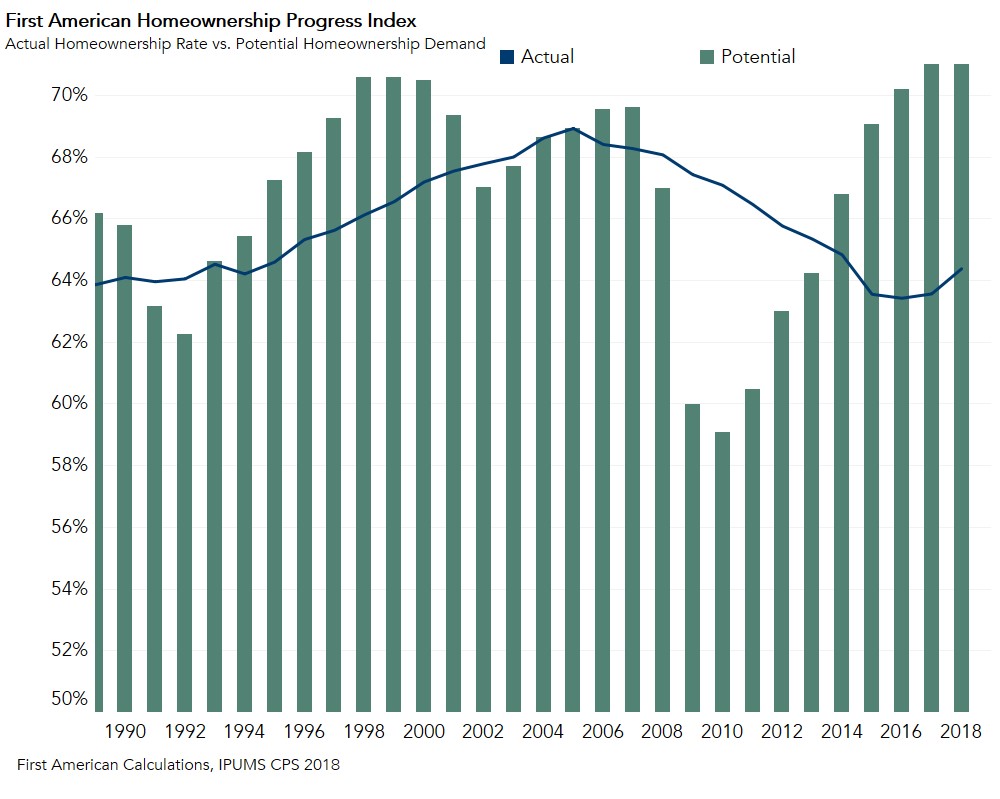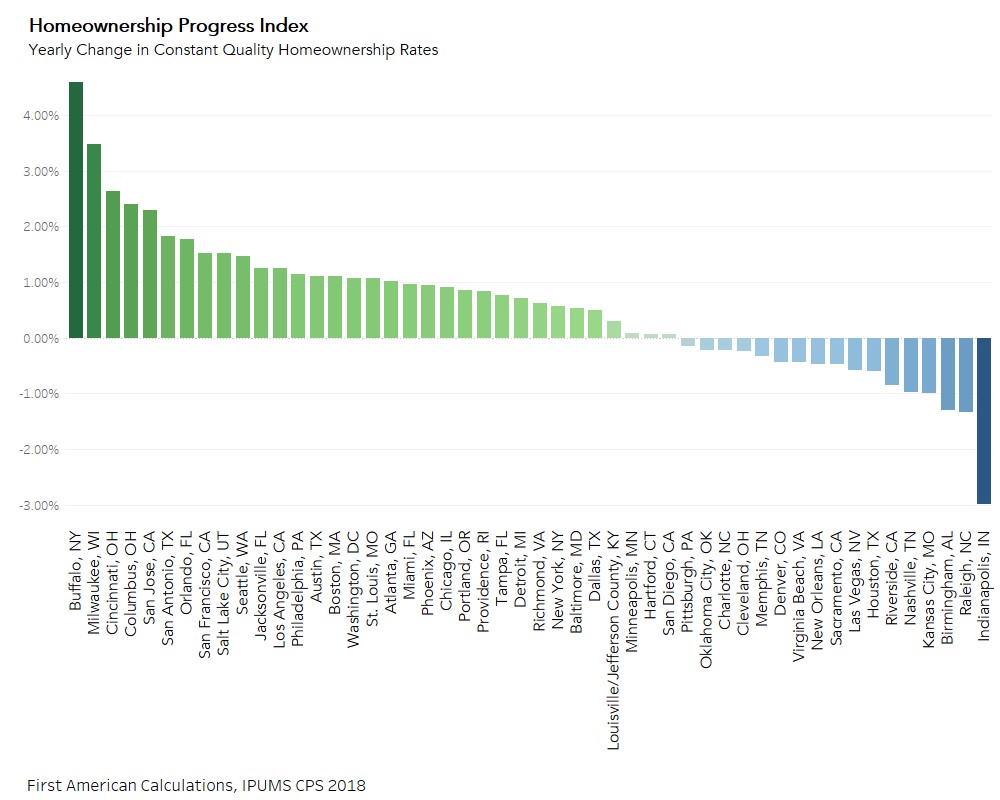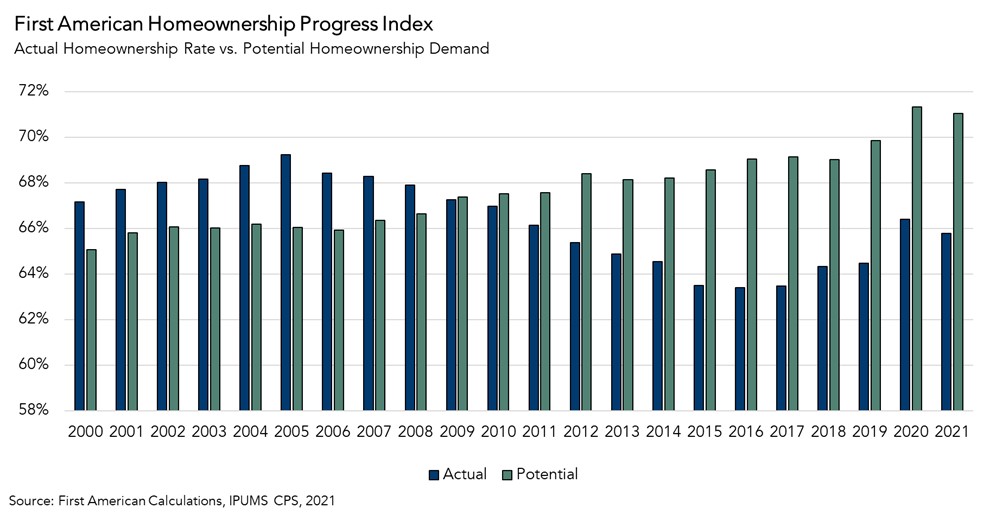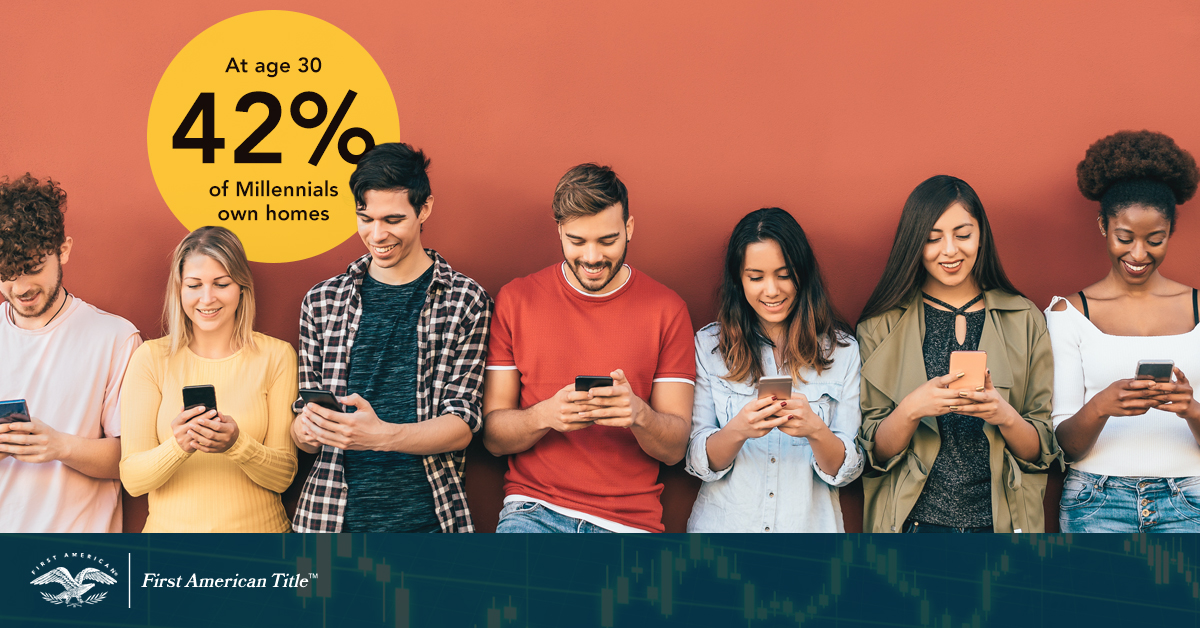Ten years after the Great Recession, homeownership remains one of the main tenets of the American Dream. Amid the recovery from the housing crisis, the homeownership rate hit a generational low of 63 percent in 2016, but it has been steadily rising since. What’s behind the steady rise since the 2016 low point? The explanation lies in the shifts in a mix of demographic and economic factors.
"We expect the homeownership rate to further close the gap with potential in the years ahead as millennials continue to make important decisions, such as attaining an education and, later in life, getting married and having children."
The homeownership rate is influenced by shifts in underlying demographic and economic factors, as well as housing market conditions. Close examination of these underlying forces can provide a more in-depth look into the changes in the homeownership rate over time. Our annual Homeownership Progress Index (HPRI) accounts for the impact of critical lifestyle, societal and economic trends on the likelihood of owning a home. Understanding these forces and tracking how they change over time allows us to measure potential homeownership demand.
Homeownership Rate Continues to Underperform Potential
The figure below shows the actual national homeownership rate versus potential homeownership demand represented by the HPRI. Historically, potential homeownership demand as measured by the HPRI has mostly outpaced the actual homeownership rate, meaning the actual homeownership rate should have been higher based on the lifestyle, societal and economic trends influencing the demand for homeownership. This was largely due to demographic trends as Baby Boomers settled down to form households of their own.
For example, in the late 1990s to the early 2000s, potential homeownership demand peaked above the actual homeownership rate. The massive Baby Boomer generation was in its prime home-buying years, driving potential demand up. However, achieving the dream of homeownership may have been restricted at the time by access to credit or the down payment necessary to purchase a first home.
There are a few distinct time periods where the actual homeownership rate exceeded potential homeownership demand, according to our HPRI. From 1984 to 1986 and again in 1992, the actual homeownership rate outperformed or equaled the potential demand, most likely a result of innovations in mortgage finance, and the economic boom of the 1990s.
The housing crisis is also an exception to this trend, where speculation, easy access to credit and exuberance caused the actual homeownership rate to exceed potential demand as measured by the HPRI. The actual homeownership rate, even while it was falling, still exceeded potential homeownership demand by nearly 7 percent in 2010.
Most recently, in 2018, the homeownership rate underperformed potential demand by 8.7 percent. When broken down by age group, we find that the majority of the demand for homeownership in 2018 and 2017 was driven by the millennial generation, those between the ages of 23 and 37. Even though they drove the bulk of actual homeownership demand in 2018, millennials and their lifestyle choices may explain why the homeownership rate remained below potential demand.

Millennial Homeownership Demand Just Beginning
Millennials are the largest generational group in the history of the U.S., and that’s not the only thing that separates them from their generational predecessors. Millennials are more diverse, more educated, and tend to marry later in life than previous generations. Many millennials have prioritized furthering their education, thus delaying getting married and having children, which are critical lifestyle triggers to buying a first home.
However, like their predecessors, millennials view homeownership as an important life goal. In fact, according to a 2019 survey, 84 percent of millennials believe homeownership is still part of the American Dream. Yet, millennials trail their generational predecessors in the pursuit of homeownership.
There is a six-percentage point difference in homeownership between millennials and Generation X at the same age of 30 years old. But, the bulk of millennials have yet to turn 30, which signals higher potential homeownership demand may be on the horizon. The largest group of millennials by birth year will turn 30 in 2020, entering their prime home-buying years.
Back to School
Millennials are officially the most educated generational cohort in U.S. history – more than 36 percent of millennials have a bachelor’s degree or higher, compared with 34 percent of Generation X and 26 percent of Baby Boomers. The share of millennials with bachelor’s degrees or higher will likely continue to rise, as younger millennials have yet to graduate. Education takes time and money, which helps explain why millennials are delaying important lifestyle decisions, such as marriage, having children or owning a home.
As educational attainment levels increase, we can expect homeownership rates will grow, as well. In fact, the importance of education to homeownership has only increased over time. Our HPRI shows that the impact of education in relation to homeownership has more than doubled in 20 years. In 1998, the difference in the homeownership rate between those with a high school degree and those with a college degree was 2.8 percent. By 2018, this gap had widened to 6.7 percent.
Is the Educational Investment Paying off?
The short answer is yes. Across generational cohorts, millennials have the highest incomes when adjusted for inflation. Comparing millennials with their predecessors at age 37, inflation-adjusted median household income is $77,000 for millennials, $72,000 for Generation X and $69,000 for Baby Boomers. Higher income leads to higher house-buying power. Coupled with today’s 3.8 percent 30-year, fixed-rate mortgage, 37-year old millennials can afford $35,000 more home than Generation X and $52,000 more home than Baby Boomers at the same age.
Put A Ring on It?
Our analysis shows that getting married is one of the strongest predictors for homeownership. Certainly, the benefit of two incomes helps to scratch together a down payment. Additionally, homeownership has historically been linked to other lifestyle decisions that are linked to homeownership, such as settling down and having kids.
Millennials, unlike their predecessors, are getting married much later in life. According to a Census study, 8 in 10 people were married by the time they turned 30 in the 1970s. Today, the same level of marriage does not occur until the age of 45. According to analysis of our HPRI, the homeownership rate in 2018 was 25 percent higher among married couples than other households.
The decision to have children also influences the decision to own. Compared with households with no children, the homeownership rate in 2018 was 6.3 percent higher for households with one or two children. Millennial lifestyle choices to delay marriage and children are part of the reason the actual homeownership rate is lower than potential homeownership demand.
Potential Demand Expected to Grow
The good news is there has been progress. Older millennials are beginning to age into the key lifestyle decisions that precede homeownership. For example, our analysis shows that the average marital rates for the millennial generation in 2018 increased 2.4 percent compared with one year ago, which contributed to the positive gain in potential homeownership demand, as well as to the increase in the actual homeownership rate in 2018.
Millennials’ lifestyle and economic decisions are important reasons why the homeownership rate remains lower than its potential, based on our HPRI. However, the gap between potential and actual homeownership in 2018 narrowed slightly as the growth in homeownership modestly exceeded the increase in potential demand. We expect the homeownership rate to further close the gap with potential in the years ahead as millennials continue to make important decisions, such as attaining an education and, later in life, getting married and having children. Looking ahead, as the bulk of millennials turn 30 next year and age into homeownership, the one question remains: will the housing market have enough homes for them to buy?
2018 HOMEOWNERSHIP PROGRESS INDEX
Overall National HPRI Increases +0.66 percent from 2017 to 2018
The First American Homeownership Progress Index (HPRI) showed that in 2018:
- Nationally, potential homeownership demand represented by the HPRI increased 0.66 percent in 2018 compared with 2017, based on changes in the underlying lifestyle, societal and economic data.
- Factors that increased potential homeownership demand included a decline in the unemployment rate (+0.84 percent), income growth (+0.11 percent), rising educational attainment (+0.10 percent), and the higher share of married households (+0.02 percent).
- The decline in the number of children per household (-0.03 percent), and the increase in the 30-year, fixed-rate mortgage rate (-0.38 percent) were factors that decreased potential homeownership demand.
- Homeownership demand increased from 2017 to 2018 in 33 of the 50 metropolitan areas tracked by First American, as demographic and economic trends in these cities raised the likelihood of homeownership.
2018 Homeownership Progress Index State Highlights
- The five states with the greatest year-over-year increase in potential homeownership demand are: Delaware (+2.0 percent), Washington, D.C. (+1.8 percent), Tennessee (+1.6 percent), Wisconsin (+1.3 percent) and New Jersey (+1.3 percent).
- The states with the greatest year-over-year decrease in potential homeownership demand are: Maine (-0.5 percent), North Carolina (-0.5 percent), North Dakota (-0.3 percent), Connecticut (-0.3 percent), and Idaho (-0.2 percent).
2018 Homeownership Progress Index Local Market Highlights
- Among the largest 50 Core Based Statistical Areas (CBSAs), the five markets with the greatest year-over-year increase in potential homeownership demand are: Buffalo, N.Y. (+4.6 percent), Milwaukee (+3.5 percent), Cincinnati (+2.6 percent), Columbus, Ohio (+2.4 percent) and San Jose, Calif. (+2.3 percent).
- Among the largest 50 CBSAs, the markets with the greatest year-over-year decrease in potential homeownership demand are: Indianapolis (-3.0 percent), Raleigh, N.C. (-1.3 percent), Birmingham, Ala. (-1.3 percent), Kansas City, Mo. (-1.0 percent), and Nashville, Tenn. (-1.0 percent).

Next Release
The next release of the First American Homeownership Progress Index will be posted in June 2020.
What makes it a Homeownership Progress Index?
Traditional measures of homeownership rates do not account for shifts in underlying demographic or economic factors. Instead, they report just the share of households that are homeowners. Analysis based on these traditionally calculated homeownership rates has resulted in mistaken conclusions that are often propagated as conventional wisdom. The HPRI provides a deeper look into the changes to homeownership rates over time by accounting for, and isolating, the impact of critical lifestyle, societal and economic trends that influence the likelihood of renting or owning a home.
Why does the HPRI tell a different story than other measures?
Changing demographic and economic factors either increase or decrease someone’s potential to be a homeowner. For example, increasing marital rates, household size, educational attainment, income and improving economic conditions all increase potential demand for homeownership. The HPRI measures the potential for homeownership demand based on these underlying factors. For example, the potential for, or likelihood of, homeownership may increase because of rising educational attainment or income growth. It’s important to point out that the likelihood of homeownership doesn’t have to match the actual homeownership rate. For example, it’s possible that someone may be highly likely to desire homeownership but are unable to find any houses they can afford to buy. In that case, potential homeownership demand would be higher than the actual homeownership rate.
What do the HPRI number values mean?
The HPRI value is the percentage of households that are likely to be homeowners, based on underlying lifestyle, societal, and economic conditions, instead of renters. Changes over time in the HPRI are caused by changes in the underlying lifestyle, societal and economic trends.
About the First American Homeownership Progress Index
The First American Homeownership Progress Index is an economic model that uses annual IPUMS CPS individual anonymized census survey data to measure the influence of household circumstances and demographic, societal and economic characteristics on one’s choice to own a home. Demographic characteristics include age, race/ethnicity, gender, marital status and number of children. Additionally, the model includes educational attainment, income, the 30-year fixed rate mortgage rate and the unemployment rate to help explain changes in homeownership rates. The individual factors influencing homeownership can be isolated, while all other factors are held equal, to provide a unique perspective on the impact the isolated factor has on the likelihood of homeownership.
The HPRI can provide the likelihood of homeownership for a given demographic and economic profile. For example, an educated man with two children and a higher income will have a higher likelihood of homeownership than a single man without a higher education degree.
Methodology
The methodology statement for the First American Homeownership Progress Index is available at http://www.firstam.com/economics/homeownership-progress-index.



